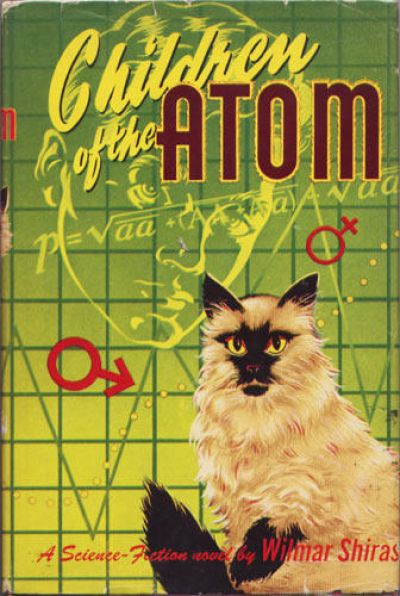An old classic new to me
Children of the Atom
By Wilmar H. Shiras

6 Sep, 2016
0 comments
Tell me if you’ve heard this story before: a well-meaning man founds a school for gifted youngsters. The gifted youngsters are mutants, children of the atom, each with their own gifts. They are mutants to whom the world will react with fear and anger when their existence is revealed.
Like most well-read SFF fans, I’d heard of Wilmar H. Shiras’ 1953 classic Children of the Atom . I had a vague idea what later works plagiarized … were inspired by Shiras’ collection. I had never actually read Children until I discovered that an ebook edition had been published. Knowing when the original text was written, where it was published, and the works it inspired, I thought I had a pretty good idea how the plot had to play out.
I was wrong.
There will be spoilers.
By 1973, the 1959 accident that left the staff of an atomic reactor dying of radiation poisoning is long forgotten. When child psychologist Peter Welles is asked to examine fourteen-year-old Tim, the accident seems to have no relevance to his patient. At a first glance, Tim seems like a perfectly normal young boy. At second glance, it becomes clear that Tim is concealing a great secret. He believes that if anyone were to learn his secret, he would become a pariah.
He’s not wrong.
The radiation that sleeted through Tim’s parents in 1959 doomed them, but transformed their unborn child. Superhumanly intelligent, Tim learned from an early age to conceal his intelligence and to adopt the guise of a perfectly average boy with perfectly average marks and perfectly normal hobbies. Nobody who knows Tim suspects the true purpose behind his cat breeding project or that he has been a published author for six years.
Welles cannot match Tim’s intellect, but what he can do is give the boy an adult in whom Tim can confide. Together, Welles and Tim can find the other orphaned, mutant offspring of the reactor staff. With a single exception, all of the mutant children are square pegs in round holes and are eager to accept a spot at Welles’ new school for gifted children.
All the children are gifted but each is gifted in a different way. None of them have encountered intellectual equals before this. Can they learn to work as a community? or have their bleak childhoods made that kind of empathy impossible? Even if they befriend each other, what will they do when a fearful world learns of the Children of the Atom?
~oOo~
If I had to describe Children of the Atom with a single unhelpful sentence, that sentence would be “imagine if the X‑Men had been written by Zenna Henderson.” Shiras seems to have been convinced that people of all intelligences were basically decent people, the occasional rabble-rousing priest aside. Virtually nobody, not even the guardians whose treatment of the Children causes the most distress, acts out of malice. Most of the conflicts in the story are the products of miscommunication or misapprehensions. The key to resolving them isn’t this:
but talking.
Shiras’ approach is possible because none of the mutants could be considered all that dangerous. There are no telepaths or telekinetics, nobody can walk through walls; nobody has the mutant power to … um … control dairy products. All of the kids are geniuses, of various kinds.
Shiras reminds me of Henderson not just because the characters are fundamentally good-natured. but because both authors share a Christian (generic) worldview. Not that everyone who pretends to be religious is good — the rabble-rouser who sends a mob the Children’s way is a rogue priest. But all the characters, good or bad, are Christians, or functionally indistinguishable from such. It is a very 1950s sort of world.
So far as I can tell, every subsequent author who borrowed from Shiras — Lee, Card, Anthony 1, and so on — rejected Shiras’ belief in communication and community. And non-violence. It’s a sad fact that there is a lot more reader-grabbing drama in a fistfight than there is in a polite conversation. Nobody is going to spend a hundred million dollars on a movie in which people talk their way to solutions. in which potential world-conquerors are handled with a heart-to-heart discussion 2.
The most … Astounding surprise was the novel’s conclusion. Now, this is a story about a secretive cabal of superhumans published by John Campbell . The canonical conclusion for stories like this is that the superhumans can either:
(1) leave the Earth behind forever, through a) emigration or b) suicide
OR
(2) remain on Earth and a) rule the lesser humans or b) eliminate them.
It’s not just Campbell, either: see stories that range from Odd John to The Chrysalids.
Shiras accepts none of these alternatives; Her kids may be hella smart, but they are still humans, with human emotional and social needs. They form a community but living apart turns out not to be the answer. Neither is running away. Instead they have to learn to integrate with society as a whole. How peculiar.
Children of the Atom was influential and widely considered a classic. It is less well known these days, possibly because it flouts some current reader expectations. This may explain why it was so often and so long out of print.
Children of the Atom is available here.
1: IMHO, Macroscope’s Project may have been a sexed-up version of the story in which the Children discover one of their number has turned on them.
2: Unless it involves marooning Matt Damon on Mars. People love Matt Damon being marooned somewhere.
